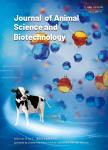Evaluation of age, weaning weight, body condition score, and reproductive tract score in pre-selected beef heifers relative to reproductive potential
Evaluation of age, weaning weight, body condition score, and reproductive tract score in pre-selected beef heifers relative to reproductive potential作者机构:1Department of Animal SciencesAuburn University559 Devall DrAuburnAL 36839USA.2Alabama Cooperative Extension SystemAuburnALUSA.
出 版 物:《Journal of Animal Science and Biotechnology》 (畜牧与生物技术杂志(英文版))
年 卷 期:2019年第10卷第2期
页 面:307-313页
核心收录:
基 金:partially funded by the Alabama Agricultural Experiment Station the Hatch program of the National Institute of Food and Agriculture,U.S.Department of Agriculture
主 题:Fertility Phenotypic selection Pregnancy outcome Replacement heifer
摘 要:Background: Artificial insemination is a preferred breeding method for beef heifers as it advances the genetic background, produces a predictive and profitable calving season, and extends the heifer’s reproductive life *** reproductive efficiency in heifers is key for the success of beef cattle production systems, following artificial insemination, heifers are exposed to a bull for the remainder of the breeding season. Altogether, up to 95% of heifers might become pregnant in their first breeding season. Heifers that do not become pregnant at the end of the breeding season represent an irreparable economical loss. Additionally, heifers conceiving late in the breeding season to natural service, although acceptable, poses serious losses to producers. To minimize losses due to reproductive failure, different phenotypic parameters can be assessed and utilized as selection tools. Here, we tested the hypothesis that in a group of pre-selected heifers, records of weaning weight, age at weaning, age at artificial insemination, and age of dam differ among heifers of varied reproductive outcomes during the first breeding ***: None of the parameters tested presented predictive ability to discriminate the heifers based on the response variable(‘pregnant to artificial insemination’, ‘pregnant to natural service’, ‘not pregnant’). Heifers categorized with body condition score = 6 and reproductive tract score ≥ 4 had the greatest proportion of pregnancy to artificial insemination(49% and 44%, respectively). Furthermore, it was notable that heifers presenting body condition score = 6 and reproductive tract score = 5 presented the greatest pregnancy rate at end of the breeding season(89%). Heifers younger than 368 d at the start of the breeding season did not become pregnant to artificial insemination. Those young heifers had 12.5% chance to become pregnant in their first breeding season,compared to 87.5% if the heifers were older than 368 ***: Our results



